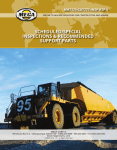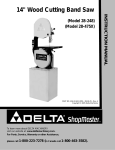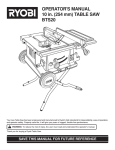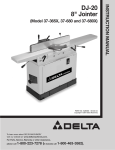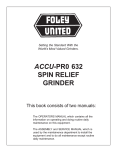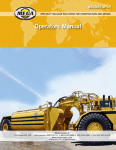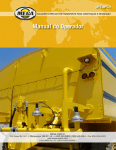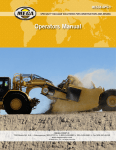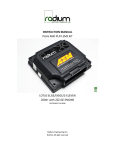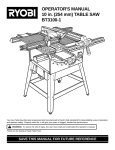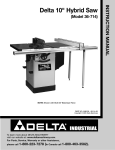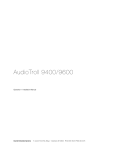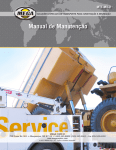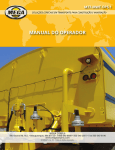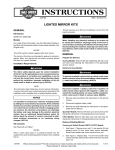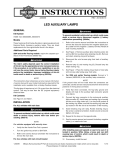Download OPERATORS MANUAL
Transcript
MHT175-CAT777-OPS-1 SPECIALTY HAULAGE SOLUTIONS FOR CONSTRUCTION AND MINING OPERATORS MANUAL MEGA CORP.® 700 Osuna Rd. N.E. • Albuquerque, NM 87113 • 1-800-345-8889 • 505-345-2661 • Fax 505-345-6190 www.megacorpinc.com ® MEGA Corp., Inc. All Rights Reserved MHT175-CAT777(G)-1 1 Aug 2012 TABLE OF CONTENTS Page Section 1. Definitions and Abbreviations …………………………………………………...…. 1-1 Section 2. System Descriptions ………………………………………………………….….… 2-1 Section 3. Normal Operations ………………………………………………………………..... 3-1 Section 4. Limitations …………………..…….……………………………………………...… 4-1 Section 5. Performance Loading .………………………………………………………………. 5-1 Section 6. Appendix ………………………………………………………………………….... 6-1 A MHT175-CAT777(G)-1 1 Aug 2012 TABLE OF CONTENTS B(Blank) MHT175-CAT777(G)-1 1 Aug 2012 SECTION 1 Definitions and Abbreviations Contents Description ………………………….….… 1-1 Warnings, Cautions & Notes ……………... 1-1 Shall, Will & May ……………................... 1-1 MHT175-CAT777(G) Overview ………… 1-2 Abbreviations ….……………………..… .. 1-3 DESCRIPTION USE OF SHALL, WILL AND MAY This technical manual contains information required to safely operate the MHT175CAT777(G). See the CAT 777G Operations and Safety manual for additional information specific to the CAT 777G chassis. Shall and Will – Used when application of a procedure is mandatory. Should – Used when application of a procedure is recommended. WARNINGS, CAUTIONS AND NOTES May - Used to indicate an acceptable or suggested means of accomplishment. The following definitions are found throughout the manual and apply as follows: Operating procedures and techniques, which could result in personal injury and/or loss of life if not carefully followed. Operating procedures and techniques, which could result in damage to equipment if not carefully followed. Operating procedures and techniques that are considered essential to emphasis. 1-1 MHT175-CAT777(G)-1 1 Aug 2012 SECTION 1 Definitions and Abbreviations MHT175 Overview 3 4 Top View 3 7 4 9 10 1 8 11 Side View 2 6 5 1 GOOSENECK 7 DECK & FENDER 2 LOWER HOPPER 8 TURN LIMIT INDICATOR 3 SIDE WALL 9 SPILL GUARD REAR BOGIE 10 SIDE BOARDS 4 11 END-OF-LOAD INDICATORS 5 REAR AXLE & WHEEL GROUP 6 HITCH & SADDLE 1-2 MHT175-CAT777(G)-1 1 Aug 2012 SECTION 1 Definitions and Abbreviations ABBREVIATIONS ft - feet gpm – gallons per minute kg – kilograms km/h – kilometers per hour lbs – pounds MHT – MEGA Coal Hauler MHT – MEGA Hauler with Truck mph – miles per hour psi - pounds per square inch 1-3 MHT175-CAT777(G)-1 1 Aug 2012 SECTION 1 Definitions and Abbreviations 1-4(Blank) MHT175-CAT777(G)-1 1 Aug 2012 SECTION 2 System Description Contents Coal Hauler Body (MHT) ………...…..... MHT Axle & Wheel Group ……............. Hitch Deck & Fender ………………....... MHT Brake System ……......................... MHT Door System ………….………….. 2-6 MHT Lube System ……………………… 2-7 MHT Lighting System …………….......… 2-7 2-1 2-3 2-3 2-4 Lower Hopper Assembly COAL HAULER BODY (MHT) The MEGA 175 ton coal hauler is modular in construction and comprised of four major sub assemblies. The sub assemblies are the gooseneck, lower hopper, side walls and the rear bogie. Gooseneck Assembly The assembly is constructed of square steel tubes, bolsters and plates. It provides for mounting of door assemblies, hydraulic actuators and lubrication blocks. The bolster passage ways provide for the routing and protection of hydraulic brake and door hosing as well as electrical cabling. Side Wall Assembly The assembly is constructed of square steel tubes, plates and channels. It contains an 18” diameter hitch ball designed to be captured in the tractor hitch socket allowing the trailer to be towed. The compartment formed by the gooseneck plating is used for mounting and routing of all brake, door and electrical system components. Components can be accessed through the manhole covers mounted on the upper deck. The walls are constructed of steel tubes and plates. They provide for mounting of clearance lights, side boards and load markers. 2-1 MHT175-CAT777(G)-1 1 Aug 2012 SECTION 2 System Description Proper straight on contact between MHT and pushing (boosting) machine is shown below: Trailing Axle Frame Assembly The trailing bogie is constructed of square steel tubes and plates. The assembly provides mounting for the rear axle assembly associated brake system accumulators filters, manifolds, and light. The rear of the bogie also contains a push type bumper assembly. Routine hard bumper contacts by the pushing (boosting) machine will cause structural fatigue and result in reduced trailer service life. The bumper may be configured as a pushblock or wrap-around style. The design provides a pushing point to assist the MHT up a grade in low traction conditions (wet, muddy or icy haul road). The bumper assembly is designed to be pushed straight on by the pushing (boosting) machine. Angled blade contact of the push-block style bumper will reduce bull dozer blade to MHT wheel clearance. Extreme blade angles will cause blade/bit to wheel contact and damage MHT tires. MHT and pushing (boosting) machine operators must communicate to maintain correct contact and maximum wheel to blade/bit clearance. Wrap-Around Style Push-Block Style 2-2 MHT175-CAT777(G)-1 1 Aug 2012 SECTION 2 System Description MHT AXLE & WHEEL GROUP the MHT hitch ball and transfer loads to the tractor. Mounting is also provided for deck and fender assemblies. Deck and Fenders The MHT trailer axle and wheel group is the same as the tractor drive axle assembly minus drive gear. It is attached to the MHT trailing axle frame by means of the same A-frame, hard pan rod and struts. For more information see the CAT operators/service manual and brake system information contained in this manual. Constructed of square steel tubes, plates, channels and grates that mounts to the hitch and saddle assembly. The assembly contains fenders, mud flaps, maintenance access doors, walkway and a work platform. Turn Limit Indicator Mechanical HITCH DECK AND FENDER Turn Limit Indicator The hitch deck and fender is modular in design and is comprised of three sub assemblies. The assemblies are the hitch and saddles, deck and fenders. Hitch and Saddles Gooseneck Stop Constructed of steel plate and mounted to the tractor chassis rails and upper deck horse collar. The turn limit indicator is designed to contact the gooseneck stops and provide visible indication of the maximum trailer rotation left or right. Constructed of steel plates and machined brass bushings. The assembly is mounted to the tractor chassis and pinned to the chassis pivot bores. The machined brass bushings capture 2-3 MHT175-CAT777(G)-1 1 Aug 2012 SECTION 2 System Description Electronic The trailer brake activation is accomplished with existing in-cab service brake pedal, secondary brake control pedals as well as the gear shift lever for parking brake. Deceleration of the vehicle from running/ operating speed is typically accomplished by using the retarder. Always consider road conditions (wet, icy or slick) when determining a means to decelerate or stop. Retainer Mounted Roller Switch MHT Service Brakes The tractor and MHT service brakes are activated by pressing on the brake control pedal. Pilot (signal) pressure from the tractor proportions brake valves allowing accumulator activation pressure to be routed to the slack adjusters and apply the brakes. In-Cab Mounted Warning Box Accumulators The system consists of a roller switch mounted on the hitch retaining plate and a warning box located in the cab. The roller switch is activated by flags mounted on the underside of the ball skirt disc. When the trailer rotates about 85° either side of center trail, the flag will activate the switch in turn providing power to activate the amber warning light and audio horn on the warning box. The system receives 24 VDC switched power from the tractor. The MHT is equipped with one additional accumulators mounted on the trailing axle frame that ensure brake activation pressure is available in close proximity to the rear axle brakes MHT BRAKE SYSTEM The MHT rear axle braking is integrated with the existing CAT 777G tractor service, secondary and parking brakes systems. MEGA has added an additional scavenge pump one additional accumulator (trailer mounted) a modified brake valve and several restrictors within the brake system to acquire a fully functional cooling and activation system. 2-4 MHT175-CAT777(G)-1 1 Aug 2012 SECTION 2 System Description Brake Valve & Slack Adjuster Groups The MHT is configured with two different brake valve and slack adjuster groups. One is mounted in the trailer rear axle and the other is on the tractor chassis on the rear frame. Slack Adjusters Parking Brake System The tractor and MHT parking brake are activated by moving the gear selector lever to the park position P. This action opens the brake retract circuit allowing the spring activated parking brake to be applied. Brake Cooling System The MHT axles receive brake cooling oil from the tractor torque converter through the oil cooler circuit. Oil is returned to the tractor cooling circuit through the added scavenge pump. Tractor Brake Valve The trailer brake valve will route activation pressure to the trailer slack adjuster to apply trailer brakes. The activation should occur first in the sequencing of the three axles (trailer, tractor drive and tractor steering). This built in delay ensures the trailer stays in trail during initial brake applications. Scavenge Pump Added Scavenge Pump The tractor drive axle brake valve will route activation pressure to the chassis drive axle slack adjusters to apply drive axle brakes. This activation will be slowed down by restrictors in the drive axle brake valve circuit. This delay will allow drive axle activation to occur second in the braking sequence. Brake Pump Hoist/Brake Cooling Pump An additional scavenge pump was added to assist in pulling MHT brake cooling oil back into the tractor cooling circuit. This scavenge pump is mounted between the tractor brake cooling pump and the brake pump. Several restrictors were added on the steering tire cooling circuit to allow proper oil return flow from the trailer. Otherwise the tractor drive axle cooling circuit is unchanged and operates per the CAT service/operators manual. Finally, the steering tire slack adjuster will receive activation pressure at a further reduced rate because of smaller restrictors feeding the steering wheel slack adjuster. This delay will ensure steering wheel activation occurs last in the braking sequence. Secondary Brake System The tractor and MHT secondary braking are activated by pressing on the secondary brake control pedal. This action opens the brake retract circuit allowing the spring activated 2-5 MHT175-CAT777(G)-1 1 Aug 2012 SECTION 2 System Description Hoist Control Lever MHT DOOR SYSTEM The system is comprised of two hinged doors, activation cylinders, hosing and a proximity switch (optional). The hydraulic door cylinders are powered hydraulics from the tractor hoist valve and controlled by the in-cab hoist control lever to open and close the doors. Hoist Control Lever LOWER RAISE FLOAT HOLD Mounted in the cab and used to open and close the MHT doors. The lever is labeled for dump body operations and performs the four functions of RAISE, HOLD, FLOAT and LOWER. See the CAT 777(G) operators manual for more system information. Hydraulics The MHT uses the in-cab hoist control lever functions as follows: RAISE - Open MHT doors. HOLD - Hold MHT doors in fixed position for transiting haul roads with or without a load. FLOAT – Disable by ECM software for trailer MHT applications. LOWER - Close MHT doors. Doors are opened and closed by hydraulic cylinders that are mounted on the doors ends (standard) or center (optional). These cylinders use hydraulic pressure routed from the tractor hoist valve to open and close the doors. The RAISE side of the hoist valve is used to open the doors while the LOWER side of the hoist valve is used to close the doors. Control of the doors is commanded by use of the in-cab hoist control lever. Door Indicator A door indicator switch is normally installed on the MHT lower hopper assembly. The door switch is intended to contact the inner door swing arm when the dump doors are in the closed position and extinguish the dump body warning light. When the doors are open the switch will illuminate the dump body warning light. Under warning light conditions the ECM will only allow preprogrammed low gear operations. . 2-6 MHT175-CAT777(G)-1 1 Aug 2012 SECTION 2 System Description Intermediate Door Position Indicator (If Equipped) A system that contains a cab mounted indicator box and an additional door position proximity switch. The indicator switch is normally installed on the MHT LH lower hopper assembly. The door switch is intended to contact the inner door swing arm when the dump doors are in a customer determined intermediate position. When doors are open to a customer determined position, the cab control box will illuminate a green light and provide an audio tone. This system is designed to assist operators in reduce/control windrow heights when performing stockpile operations. MHT LUBE SYSTEM The MHT is lubricated through central lubrication blocks that may be connected to the tractor auto lube system if installed. Lubrication blocks service MHT axle A-frame, hardpan rod, axle struts, hydraulic cylinder pins and hitch ball socket assembly MHT LIGHTING SYSTEM The system contains brake, turn signal, backing, clearance and work lights. Some optional lighting features may include load, backing and auxiliary equipment lighting. All lighting is controlled by existing switches mounted in the cab or modified by dealers to operate at a junction box or added in-cab control box. 2-7 MHT175-CAT777(G)-1 1 Aug 2012 SECTION 2 System Description 2-8(Blank) MHT175-CAT777(G)-1 1 Aug 2012 SECTION 3 Limitations Contents Maximum Allowable Weights ………..… 3-1 MHT Gooseneck …………………..…… 3-1 MAXIMUM ALLOWABLE WEIGHTS 2. OSCILLATION The hitch ball is limited to 12° as shown below. 1. Maximum allowable gross machine weight is 627,202 lbs/284,494 kg 12 ° 2. Maximum allowable load for the MHT is: a. 175 tons b. 350,000lbs c. 158,758kg Operating the MHT above maximum load will decrease MHT structure and component service life. Hitch ball oscillations greater than 12° will result in hitch ball contact with hitch socket upper retaining plate. Repeated contact may cause failure of upper hitch socket retaining plate bolts and reduce service life of the hitch ball assembly. MHT GOOSENECK 1. ARTICULATION The gooseneck is limited to 90° articulation right and left of centerline trail as shown below. MHT Top View Gooseneck articulation beyond 90° will result in turn limit indicator to gooseneck stop contact. Repeated contact may cause damage to stops and indicators. 3-1 MHT175-CAT777(G)-1 1 Aug 2012 SECTION 3 Limitations 3-2(Blank) MHT175-CAT777(G)-1 1 Aug 2012 SECTION 4 Normal Operations Contents Maximum Allowable Weights………… Weight & Dimensions ……………..….. Before Operations ………….………..… Operations ……….…………………..… Loading ………………………………… Transitioning With A Load ………….... Unloading (Stationary or Moving)..…… After Operations ……………….……… 4-1 4-1 4-2 4-2 4-2 4-3 4-3 4-3 The MHT normal operating procedures mirror the established CAT format of operations. The procedures are separated into before operations, operations and after operations. A pocket size checklist of all MHT procedures is contained in the Appendix for use in the vehicle cab. DESCRIPTION This section provides the vehicle operator with step by step procedures used to operate the MHT system only. See the CAT 777(G) operators’ manual for specific tractor operations and system details. WEIGHT AND DIMENSIONS MHT175-CAT777(G) Empty Weight = 231,517 LBS/105,015 KG 4-1 MHT175-CAT777(G)-1 1 Aug 2012 SECTION 4 Normal Operations 13. LH Door Hydraulic Cylinders, Structure Cavity Drain Holes and Lights – CHECKED FOR DAMAGE, SECURITY AND LEAKS BEFORE OPERATIONS These procedures are used to perform a walkaround inspection of the MHT system before use or beginning of the shift. This inspection is in addition to and does not replace the CAT 777(G) inspection requirements. 14. Trailer Axle Frame Assembly, Axle Assembly, Manifolds and Accumulators – CHECK FOR DAMAGE, SECURITY AND LEAKS 1. Vehicle Engine – AS REQUIRED 2. Chocks – INSTALLED AS REQUIRED 15. Tail Light Assemblies – CHECKED FOR DAMAGE 3. Transmission Control Lever – P (Park) 4. Hoist Control Lever – HOLD 16. RH Door Hydraulic Cylinders, Structure Cavity Drain Holes and Lights – CHECKED FOR DAMAGE, SECURITY AND LEAKS 5. Hitch Ball Retaining Plate –– CHECKED FOR DAMAGE AND SECURITY (Lift ball skirt and check for loose or sheared bolt heads.) 17. RH Hitch Deck and Fender – CHECKED FOR DAMAGE AND SECURED 6. Turn Limit Indicator – CHECKED FOR SECURITY AND DAMAGE 18. (If Equipped) RH Consolidated Service Center – LEVELS CHECKED. 7. Upper Deck Assembly – CHECKED FOR DAMAGE AND SECURITY OPERATIONS Use these procedures to safely operate the standard and optional systems installed on the MHT175-CAT777(G). 8. Upper Hitch and Hydraulic Hosing – CHECKED FOR DAMAGE, SECURITY AND LEAKS LOADING 1. Hoist Control Lever – LOWER (Doors fully closed) then immediately to HOLD 9. Upper Gooseneck and Hosing – CHECKED FOR DAMAGE, SECURITY AND LEAKS 10. Chassis Hydraulic Tank – SERVICED If doors do not fully close and the body position light is on, cycle the hoist control lever to LOWER (doors closed) then immediately back to HOLD. Ensure the body position warning light is off. 11. LH Hitch Deck and Fender – CHECKED AND SECURED 12. Gooseneck, Access Panels and Mud Flaps – CHECKED AND SECURED 2. Hoist Control Lever – HOLD 3. Body Position Warning Light – OFF 4-2 MHT175-CAT777(G)-1 1 Aug 2012 SECTION 4 Normal Operations 4. Positioned MHT for loading within the load markers. UNLOADING (Moving) 5. Transmission Control Lever – P (Park It is highly recommended a dozer be available to keep dump entry and exit paths level during stockpile operations. 6. On-Load – As Required Once on-load is complete 1. When entering stockpile to dump, find a level area that will not require any turning once the dump has started. 7. Transmission Control Lever – As Required 8. Move away from the loading area. 2. The truck should be locked in first or second gear. TRANSITING WITH A LOAD 1. While driving periodically scan side view mirrors for evidence of doors opening. 3. Determine a safe ground speed for the dump pass based on environmental/road conditions, stockpile route, and appropriate material flow to prevent trailer axle high centering or hitch over oscillation;. 2. Body Position Warning Light – OFF UNLOADING (Stationary) 1. Position MHT for unloading. 4. After the unit has entered the stockpile and is locked in the correct gear and is in a straight line with the desired ground speed established, the dump doors can be opened to an intermediate position. 2. Brakes – As Required 3. Hoist Control Lever – AS DESIRED TO DUMP LOAD 5. When opening the dump doors they should not be opened up all the way to keep material from flowing underneath the trailer tires. The doors should be opened slowly by bumping the dump lever. (Three to four bumps on the dump lever is all that is required). Use intermediate door position system if equipped Once load is dumped 4. Hoist Control Lever – LOWER (Doors fully closed) then immediately to HOLD If doors do not fully close and the body position light is on, cycle the hoist control lever to LOWER (doors closed) then immediately back to HOLD. Ensure the body position warning light is off. 6. The operator should string out the load so that the trailer doesn’t ride up on the coal that is being dumped. 5. Hoist Control Lever – HOLD 4-3 MHT175-CAT777(G)-1 1 Aug 2012 SECTION 3 Normal Operations 5. Hitch Ball Retaining Plate –– CHECKED FOR DAMAGE AND SECURITY (Lift ball skirt and check for loose or sheared bolt heads.) Hitch ball oscillations greater than 12° will result in hitch ball contact with hitch socket upper retaining plate. Repeated contact may cause failure of upper hitch socket retaining plate bolts and reduce service life of the hitch ball assembly. 6. Turn Limit Indicator – CHECKED FOR SECURITY AND DAMAGE 7. Upper Deck Assembly – CHECKED FOR DAMAGE AND SECURITY 7. Once the trailer has been dumped the operator can then allow the truck to shift as necessary while he/she is closing the doors. 8. Upper Hitch and Hydraulic Hosing – CHECKED FOR DAMAGE, SECURITY AND LEAKS 8. Once the doors have reached the closed position the operator must then return the dump lever to the hold position with no hesitation in the float setting. 9. Upper Gooseneck and Hosing – CHECKED FOR DAMAGE, SECURITY AND LEAKS 9. If there is any hesitation passing through the float position, the operator must reopen the doors slightly and close them again without hesitation. 10. Chassis Hydraulic Tank – SERVICED 10. Continue Safely back to the pit driving appropriate to the road conditions. 12. Gooseneck, Access Panels and Mud Flaps CHECKED AND SECURED AFTER OPERATIONS 13. LH Door Hydraulic Cylinders, Structure Cavity Drain Holes and Lights – CHECKED FOR DAMAGE, SECURITY AND LEAKS 11. LH Hitch Deck and Fender – CHECKED AND SECURED These procedures are used to perform a walkaround inspection after using the MHT175CAT777(G) system. This inspection is in addition to and does not replace the CAT 777(G) inspection requirements. 14. Trailer Axle Frame Assembly, Axle Assembly, Manifolds and Accumulators – CHECK FOR DAMAGE, SECURITY AND LEAKS 1. Vehicle Engine – AS REQUIRED 2. Chocks – INSTALLED AS REQUIRED 15. Tail Light Assemblies – CHECKED FOR DAMAGE 3. Transmission Control Lever – P (Park) 4. Hoist Control Lever – HOLD 4-4 MHT175-CAT777(G)-1 1 Aug 2012 SECTION 4 Normal Operations 16. RH Door Hydraulic Cylinders, Structure Cavity Drain Holes and Lights – CHECKED FOR DAMAGE, SECURITY AND LEAKS 6. Confirm with maintenance and perform actual inspection of the chassis systems to ensure the following brake and control system configuration exist. 17. RH Hitch Deck and Fender – CHECKED FOR DAMAGE AND SECURED Brake Cooling Manifold (RT Side) 18. (If Equipped) RH Consolidated Service Center – LEVELS CHECKED. a. A jumper hose connects the brake cooling port to the brake return port (-32 fitting). DECOUPLED OPERATIONS Brake Activation Manifold (LT Side) The procedures are used to operate the chassis with the trailer removed (decoupled). Decoupled operations can only be attempted when the brake and associated control systems are reconfigured for decoupled operations. b. Grease port trailer supply port is capped off (-8 fitting). c. Brake accumulator trailer supply port is capped off (-16 fitting). d. Trailer service return port is capped off (-16 fitting). Do not operate the chassis (decoupled) from the trailer unless the brake and associated control systems are configured properly. Failure to ensure proper brake system configuration exists, may result in inoperative service, parking and secondary brake systems. Operating the chassis with inoperative brake systems may result in personal injury or death. e. Trailer E-Brake/Parking brake retract supply port is capped off (-10 fitting). f. Trailer service brake signal in and out ports (-8 fittings). Control System INSPECTION g. Chassis mounted junction box or Yharness connection is configured or jumpered to allow normal tail light and backup alarm functions. 1. Vehicle Engine – AS REQUIERED 2. Chocks – INSTALLED 3. Transmission Control Lever –P (Park) 7. Ensure hitch and deck area are clear of tools and debris. 4. Hoist Control Lever – HOLD 8. Vehicle Engine - Start 5. Gain access to forward hitch area by using the deck assembly. Identify the LT and RT junction manifolds. 4-5 MHT175-CAT777(G)-1 1 Aug 2012 SECTION 3 Normal Operations 9. While machine is running and parking brake function is assured, check reconfigured manifolds for leaks. 10. Check brake lights, turn signals and back up alarm are functioning properly. 11. Chocks – REMOVED OPERATION 12. Front Brake Activation Switch – ON 13. Ensure parking brake is functioning. Ensure parking brake advisory light illuminates when gear selector is in park (P). Do not operate the machine if the parking brake system is malfunctioning or inoperative. 14. Gear Selector Lever – “D” Drive. 15. At 3-5 MPH activate the service brake to ensure proper function. Do not operate the machine if the service brake system is malfunctioning or inoperative. 16. Once all brake and control systems are operating properly, move the machine as required. 17. Continue to monitor brake cooling temperatures to ensure brakes are not dragging or a malfunction exists in the cooling circuit. 4-6 MHT175-CAT777(G)-1 1 Aug 2012 SECTION 5 Performance Loading MHT LOADING Figure 5-1 illustrates correct load placement and height. Figure 5-1 Load Placement & Height 5-1 MHT175-CAT777(G)-1 1 Aug 2012 SECTION 5 Performance Loading 5-2(Blank) MHT175-CAT777(G)-1 1 Aug 2012 SECTION 6 Appendix MHT175-CAT777(G)CL-1 1 Aug 2012 MHT175 OPERATORS CHECKLIST 6-1 MHT175-CAT777(G)-1 1 Aug 2012 SECTION 6 Appendix MHT175-CAT777(G)CL-1 1 Aug 2012 TABLE OF CONTENTS Title Page 1. BEFORE OPERATIONS……..…….. N-2 2. OPERATIONS A. Loading (Stationary or Moving) N-4 B. Transiting with a Load ….…… N-5 C. Unloading …………………… N-6 3. AFTER OPERATIONS…………… N-7 4. DECOUPLED OPERATIONS…… ..N-9 N-1 6-2 MHT175-CAT777(G)-1 1 Aug 2012 SECTION 6 Appendix MHT175-CAT777(G)CL-1 1 Aug 2012 BEFORE OPERATIONS These procedures are used to perform a walk-around inspection of the MHT175-CAT777(G) system before use or beginning of the shift. This inspection is in addition to and does not replace the CAT 777(G) inspection requirements. These procedures are used to perform a walk-around inspection of the MHT system before use or beginning of the shift. This inspection is in addition to and does not replace the CAT 777(G) inspection requirements. 1. Vehicle Engine – AS REQUIRED 2. Chocks – INSTALLED 3. Transmission Control Lever – P (Park) 4. Hoist Control Lever – HOLD 5. Hitch Ball Retaining Plate – CHECKED FOR DAMAGE AND SECURITY (Lift ball skirt and check for loose or sheared bolt heads.) 6. Turn Limit Indicator – CHECKED FOR SECURITY AND DAMAGE N-2 6-3 MHT175-CAT777(G)-1 1 Aug 2012 SECTION 6 Appendix MHT175-CAT777(G)CL-1 1 Aug 2012 7. Upper Deck Assembly – CHECKED FOR DAMAGE AND SECURITY 8. Upper Hitch and Hydraulic Hosing – CHECKED FOR DAMAGE, SECURITY AND LEAKS 9. Upper Gooseneck and Hosing – CHECKED FOR DAMAGE, SECURITY AND LEAKS 10. Chassis Hydraulic Tank - SERVICED 11. LH Hitch Deck and Fender – CHECKED AND SECURED 12. Gooseneck, Access Panels and Mud Flaps – CHECKED AND SECURED 13. LH Door Hydraulic Cylinders, Structure Cavity Drain Holes and Lights – CHECKED FOR DAMAGE, SECURITY AND LEAKS 14. Trailer Axle Frame Assembly, Axle Assembly, manifolds and Accumulators - CHECK FOR DAMAGE, SECURITY AND LEAKS. N-3 6-4 MHT175-CAT777(G)-1 1 Aug 2012 SECTION 6 Appendix MHT175-CAT777(G)CL-1 1 Aug 2012 15. Tail Lights Assemblies – CHECKED FOR DAMAGE 16. RH Door Hydraulic Cylinders, Structure Cavity Drain Holes and Lights – CHECKED FOR DAMAGE, SECURITY AND LEAKS 17. RH Hitch Deck and Fender – CHECKED FOR DAMAGE AND SECURED 18. (If Equipped) RH Consolidated Service Center – Levels Checked. OPERATIONS Use these procedures to safely operate the standard and optional systems installed on the MHT175CAT777(G). N-4 6-5 MHT175-CAT777(G)-1 1 Aug 2012 SECTION 6 Appendix MHT175-CAT777(G)CL-1 1 Aug 2012 LOADING 1. Hoist Control Lever – LOWER (Doors fully closed) then immediately to HOLD If doors do not fully close and the body position light is on, cycle the hoist control lever to LOWER (doors closed) then immediately back to HOLD. Ensure the body position warning light is off. 2. Hoist Control Lever – HOLD 3. Body Position Warning Light – OFF 4. Positioned MHT for loading within the load markers. 5. Transmission Control Lever – P (Park) 6. On-Load – As Required Once on-load is complete 7. Transmission Control Lever – As Required 8. Move away from the loading area. N-5 6-6 MHT175-CAT777(G)-1 1 Aug 2012 SECTION 6 Appendix MHT175-CAT777(G)CL-1 1 Aug 2012 TRANSITING WITH A LOAD 1. While driving periodically scan side view mirrors for evidence of doors opening. 2. Body Position Warning Light – OFF UNLOADING (Stationary) 1. Position MHT for unloading. 2. Brakes – As Required 3. Hoist Control Lever – AS DESIRED TO DUMP LOAD Once load is dumped 4. Hoist Control Lever – LOWER (Doors fully closed) then immediately to HOLD If doors do not fully close and the body position light is on, cycle the hoist control lever to LOWER (doors closed) then immediately back to HOLD. Ensure the body position warning light is off. N-6 6-7 MHT175-CAT777(G)-1 1 Aug 2012 SECTION 6 Appendix MHT175-CAT777(G)CL-1 1 Aug 2012 5. Hoist Control Lever – HOLD UNLOADING (Moving) It is highly recommended a dozer be available to keep dump entry and exit paths level during stockpile operations. 1. When entering stockpile to dump, find a level area that will not require any turning once the dump has started. 2. The truck should be locked in first or second gear. 3. Determine a safe ground speed for the dump pass based on environmental/road conditions, stockpile route, and appropriate material flow to prevent trailer axle high centering or hitch over oscillation. 4. After the unit has entered the stockpile and is locked in the correct gear and is in a straight line with the desired ground speed established, the dump doors can be opened to an intermediate position. N-7 6-8 MHT175-CAT777(G)-1 1 Aug 2012 SECTION 6 Appendix MHT175-CAT777(G)CL-1 1 Aug 2012 5. When opening the dump doors they should not be opened up all the way to keep material from flowing underneath the trailer tires. The doors should be opened slowly by bumping the dump lever. (Three to four bumps on the dump lever is all that is required). Use intermediate door position system if equipped. 6. The operator should string out the load so that the trailer doesn’t ride up on the coal that is being dumped. Hitch ball oscillations greater than 12° will result in hitch ball contact with hitch socket upper retaining plate. Repeated contact may cause failure of upper hitch socket retaining plate bolts and reduce service life of the hitch ball assembly. 7. Once the trailer has been dumped the operator can then allow the truck to shift as necessary while he/she is closing the doors. 8. Once the doors have reached the closed position the operator must then return the dump lever to the hold position with no hesitation in the float setting. N-8 6-9 MHT175-CAT777(G)-1 1 Aug 2012 SECTION 6 Appendix MHT175-CAT777(G)CL-1 1 Aug 2012 9. If there is any hesitation passing through the float position, the operator must reopen the doors slightly and close them again without hesitation. 10. Continue safely back to the pit driving appropriate to the road conditions. AFTER OPERATIONS These procedures are used to perform a walk-around inspection after using the MHT175-CAT777(G) system. This inspection is in addition to and does not replace the CAT 777(G) inspection requirements. 1. Transmission Control Lever – P (Park) 2. Vehicle Engine – AS REQUIRED 3. Hoist Control Lever – HOLD 4. Turn Limit Indicator – CHECKED DAMAGE AND SECURITY FOR 5. Upper Deck Assembly – CHECKED FOR DAMAGE AND SECURITY N-9 6-10 MHT175-CAT777(G)-1 1 Aug 2012 SECTION 6 Appendix MHT175-CAT777(G)CL-1 1 Aug 2012 6. Upper Hitch and Hydraulic Hosing – CHECKED FOR DAMAGE, SECURITY AND LEAKS 7. Upper Gooseneck and Hosing – CHECKED FOR DAMAGE, SECURITY AND LEAKS 8. Chocks – INSTALLED 9. Vehicle Hydraulic Tank – SERVICED 10. LH Hitch Deck and Fender – CHECKED FOR DAMAGE AND SECURED 11. Gooseneck, Access Panels and Mud Flaps – CHECKED AND SECURED 12. LH Door Hydraulic Cylinders, Structure Cavity Drain Holes and Lights – CHECKED FOR DAMAGE, SECURITY AND LEAKS 13. Rear Bogie, Axle Assembly, Filters and Accumulators – CHECK FOR DAMAGE LEAKS AND SECURITY N-10 6-11 MHT175-CAT777(G)-1 1 Aug 2012 SECTION 6 Appendix MHT175-CAT777(G)CL-1 1 Aug 2012 14. Tail Light DAMAGE Assemblies – CHECKED FOR 15. RH Hitch Deck and Fender – CHECKED AND SECURED DECOUPLED OPERATIONS The procedures are used to operate the chassis with the trailer removed (decoupled). Decoupled operations can only be attempted when the brake and associated control systems are reconfigured for decoupled operations. Do not operate the chassis (decoupled) from the trailer unless the brake and associated control systems are configured properly. Failure to ensure proper brake system reconfiguration exists may result in inoperative service, parking and secondary brake systems, operating the chassis with inoperative brake systems mat result in personal injury or death. N-11 6-12 MHT175-CAT777(G)-1 1 Aug 2012 SECTION 6 Appendix MHT175-CAT777(G)CL-1 1 Aug 2012 INSPECTION 1. Vehicle Engine – AS REQUIRED 2. Chocks – INSTALLED 3. Transmission Control Lever – P (Park) 4. Hoist Control Lever – HOLD 5. Gain access to forward hitch area by using the deck assembly. Identify the LT and RT junction manifolds. 6. Confirm with Maintenance and perform actual inspection of the chassis systems to ensure the following brake and control system configuration Brake Cooling Manifold (RT side) A. A jumper hose connect the brake cooling port to the brake return port (-32 fitting). N-12 6-13 MHT175-CAT777(G)-1 1 Aug 2012 SECTION 6 Appendix MHT175-CAT777(G)CL-1 1 Aug 2012 Brake Activation Manifold (LT) B. Grease port trailer supply port is capped of f ( - 8 fitting). C. Brake accumulator trailer supply port is capped off (-16 fitting) D. Trailer service return port is capped off (-16 fitting) E. Trailer E-Brake/Parking brake retract supply port is capped off (-10 fitting). F. Trailer service brake signal in and out ports (-8 fittings) Control System G. Chassis mounted junction box or Y – harness connection is configured or jumpered to allow normal tail light and backup alarm functions. 7. Ensure hitch and deck area are clear of tools and debris. N-13 6-14 MHT175-CAT777(G)-1 1 Aug 2012 SECTION 6 Appendix MHT175-CAT777(G)CL-1 1 Aug 2012 8. Vehicle Engine – Start 9. While machine is running and parking brake function is assured, check reconfigured manifolds for leaks. 10. Check brake lights, turn signals and back up alarm are functioning properly. 11. Chocks - REMOVED OPERATION 12. Front Brake Activation Switch – ON 13. Ensure parking brake is functioning. Ensure parking brake advisory light illuminates when gear selector is in park (P). Do not operate the machine if the parking brake system is malfunctioning or inoperative. 14. Gear Selector Lever – “D” Drive N-14 6-15 MHT175-CAT777(G)-1 1 Aug 2012 SECTION 6 Appendix MHT175-CAT777(G)CL-1 1 Aug 2012 15. At 3-5 MPH activate the service brake to ensure proper function. Do not operate the machine if the service brake system is malfunctioning or inoperative. 16. Once all brake and control systems are operating properly, move the machine as required. 17. Continue to monitor brake cooling temperatures to ensure brakes are not dragging or a malfunction exists in the cooling circuit. N-15 6-16










































